Related Research Articles

A cathode-ray tube (CRT) is a vacuum tube containing one or more electron guns, which emit electron beams that are manipulated to display images on a phosphorescent screen. The images may represent electrical waveforms on an oscilloscope, a frame of video on an analog television set (TV), digital raster graphics on a computer monitor, or other phenomena like radar targets. A CRT in a TV is commonly called a picture tube. CRTs have also been used as memory devices, in which case the screen is not intended to be visible to an observer. The term cathode ray was used to describe electron beams when they were first discovered, before it was understood that what was emitted from the cathode was a beam of electrons.
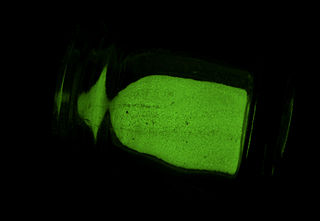
A phosphor is a substance that exhibits the phenomenon of luminescence; it emits light when exposed to some type of radiant energy. The term is used both for fluorescent or phosphorescent substances which glow on exposure to ultraviolet or visible light, and cathodoluminescent substances which glow when struck by an electron beam in a cathode-ray tube.
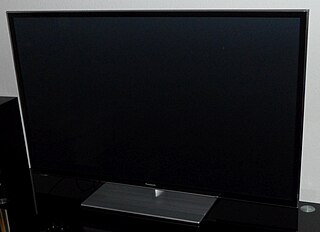
A plasma display panel is a type of flat-panel display that uses small cells containing plasma: ionized gas that responds to electric fields. Plasma televisions were the first large flat-panel displays to be released to the public.

A display device is an output device for presentation of information in visual or tactile form. When the input information that is supplied has an electrical signal the display is called an electronic display.

A video projector is an image projector that receives a video signal and projects the corresponding image onto a projection screen using a lens system. Video projectors use a very bright ultra-high-performance lamp, Xenon arc lamp, metal halide lamp, LED or solid state blue, RB, RGB or fiber-optic lasers to provide the illumination required to project the image. Most modern projectors can correct any curves, blurriness and other inconsistencies through manual settings.
A television set or television receiver is an electronic device for the purpose of viewing and hearing television broadcasts, or as a computer monitor. It combines a tuner, display, and loudspeakers. Introduced in the late 1920s in mechanical form, television sets became a popular consumer product after World War II in electronic form, using cathode ray tube (CRT) technology. The addition of color to broadcast television after 1953 further increased the popularity of television sets in the 1960s, and an outdoor antenna became a common feature of suburban homes. The ubiquitous television set became the display device for the first recorded media for consumer use in the 1970s, such as Betamax, VHS; these were later succeeded by DVD. It has been used as a display device since the first generation of home computers and dedicated video game consoles in the 1980s. By the early 2010s, flat-panel television incorporating liquid-crystal display (LCD) technology, especially LED-backlit LCD technology, largely replaced CRT and other display technologies. Modern flat-panel TVs are typically capable of high-definition display and can also play content from a USB device. Starting in the late 2010s, most flat-panel TVs began to offer 4K and 8K resolutions.
A field-emission display (FED) is a flat panel display technology that uses large-area field electron emission sources to provide electrons that strike colored phosphor to produce a color image. In a general sense, an FED consists of a matrix of cathode ray tubes, each tube producing a single sub-pixel, grouped in threes to form red-green-blue (RGB) pixels. FEDs combine the advantages of CRTs, namely their high contrast levels and very fast response times, with the packaging advantages of LCD and other flat-panel technologies. They also offer the possibility of requiring less power, about half that of an LCD system. FEDs can also be made transparent.
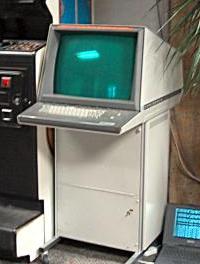
Storage tubes are a class of cathode-ray tubes (CRTs) that are designed to hold an image for a long period of time, typically as long as power is supplied to the tube.

Direct-view bistable storage tube (DVBST) was an acronym used by Tektronix to describe their line of storage tubes. These were cathode ray tubes (CRT) that stored information written to them using an analog technique inherent in the CRT and based upon the secondary emission of electrons from the phosphor screen itself. The resulting image was visible in the continuously glowing patterns on the face of the CRT.

A surface-conduction electron-emitter display (SED) is a display technology for flat panel displays developed by a number of companies. SEDs uses nanoscopic-scale electron emitters to energize colored phosphors and produce an image. In a general sense, a SED consists of a matrix of tiny cathode-ray tubes, each "tube" forming a single sub-pixel on the screen, grouped in threes to form red-green-blue (RGB) pixels. SEDs combine the advantages of CRTs, namely their high contrast ratios, wide viewing angles, and very fast response times, with the packaging advantages of LCD and other flat panel displays.
This is a comparison of various properties of different display technologies.
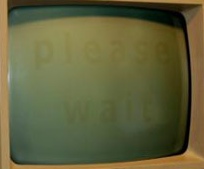
Screen burn-in, image burn-in, ghost image, or shadow image, is a permanent discoloration of areas on an electronic visual display such as a cathode-ray tube (CRT) in an older computer monitor or television set. It is caused by cumulative non-uniform use of the screen.

A CRT projector is a video projector that uses a small, high-brightness cathode ray tube (CRT) as the image generating element. The image is then focused and enlarged onto a screen using a lens kept in front of the CRT face. The first color CRT projectors came out in the early 1950s. Most modern CRT projectors are color and have three separate CRTs, and their own lenses to achieve color images. The red, green and blue portions of the incoming video signal are processed and sent to the respective CRTs whose images are focused by their lenses to achieve the overall picture on the screen. Various designs have made it to production, including the "direct" CRT-lens design, and the Schmidt CRT, which employed a phosphor screen that illuminates a perforated spherical mirror, all within an evacuated cathode ray tube.
Cromaclear is a trademark for CRT technology used by NEC during the mid to late-90s. This adopted the slotted shadow mask and in-line electron gun pioneered by the 1966 GE Porta-Color and used by most then-current television tubes to computer monitor use. It was claimed that Cromaclear could offer the image clarity and sharpness of the Trinitron and Diamondtron aperture grille CRTs without the disadvantages e.g. expense and the horizontal damping wires.

A raster scan, or raster scanning, is the rectangular pattern of image capture and reconstruction in television. By analogy, the term is used for raster graphics, the pattern of image storage and transmission used in most computer bitmap image systems. The word raster comes from the Latin word rastrum, which is derived from radere ; see also rastrum, an instrument for drawing musical staff lines. The pattern left by the lines of a rake, when drawn straight, resembles the parallel lines of a raster: this line-by-line scanning is what creates a raster. It is a systematic process of covering the area progressively, one line at a time. Although often a great deal faster, it is similar in the most general sense to how one's gaze travels when one reads lines of text.
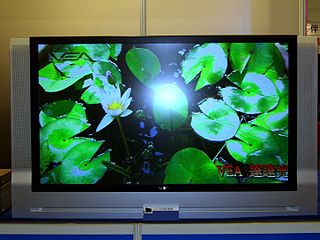
Large-screen television technology developed rapidly in the late 1990s and 2000s. Prior to the development of thin-screen technologies, rear-projection television was standard for larger displays, and jumbotron, a non-projection video display technology, was used at stadiums and concerts. Various thin-screen technologies are being developed, but only liquid crystal display (LCD), plasma display (PDP) and Digital Light Processing (DLP) have been publicly released. Recent technologies like organic light-emitting diode (OLED) as well as not-yet-released technologies like surface-conduction electron-emitter display (SED) or field-emission display (FED) are in development to supersede earlier flat-screen technologies in picture quality.

Rear-projection television (RPTV) is a type of large-screen television display technology. Until approximately 2006, most of the relatively affordable consumer large screen TVs up to 100 in (250 cm) used rear-projection technology. A variation is a video projector, using similar technology, which projects onto a screen.
Display motion blur, also called HDTV blur and LCD motion blur, refers to several visual artifacts that are frequently found on modern consumer high-definition television sets and flat-panel displays for computers.
An electronic visual display is a display device that can display images, video, or text that is transmitted electronically. Electronic visual displays include television sets, computer monitors, and digital signage. They are ubiquitous in mobile computing applications like tablet computers, smartphones, and information appliances. Many electronic visual displays are informally referred to as screens.
Electrically operated display devices have developed from electromechanical systems for display of text, up to all-electronic devices capable of full-motion 3D color graphic displays. Electromagnetic devices, using a solenoid coil to control a visible flag or flap, were the earliest type, and were used for text displays such as stock market prices and arrival/departure display times. The cathode ray tube was the workhorse of text and video display technology for several decades until being displaced by plasma, liquid crystal (LCD), and solid-state devices such as thin-film transistors (TFTs), LEDs and OLEDs. With the advent of metal–oxide–semiconductor field-effect transistors (MOSFETs), integrated circuit (IC) chips, microprocessors, and microelectronic devices, many more individual picture elements ("pixels") could be incorporated into one display device, allowing graphic displays and video.
References
- 1 2 B2 USpatent US8232957 B2,Roger A. Hajjar, David Kent, Phillip Malyak,"Laser displays using phosphor screens emitting visible colored light",issued July 31, 2012
- 1 2 "Fortune India: Boss, I shrunk the office". Fortune India, 2017-06-30
- ↑ Siegler, MG "LPD: Prysm's New Acronym Promises Huge Screens, 75% Less Power Consumption". TechCrunch, 2010-01-12
- 1 2 3 Clancy, Heather. "Is This The World's Greenest Video Wall?". Forbes (magazine), 2013-12-19
- 1 2 Greene, Kate. "A New Breed of Laser TV". MIT Technology Review, 2010-01-20
- 1 2 3 "Laser Phosphor Display (LPD) television - it's all done with mirrors". Phys.org, 2010-06-01
- ↑ Roush, Wade. "Prysm Hopes Laser-Driven Screens Will Outshine LCD, LED Displays". Xconomy, 2010-01-13
- 1 2 Ayala, David. "LPD HDTVs: Are they the future or late to the party?". PC World, 2010-01-15
- ↑ "Laser Phosphor Display - How It Works". Prysm
- ↑ "Prysm's Ecovative Laser Phosphor Displays (LPDs): Consumer Tech Will Have To Wait". Phys.org, 2010-01-19
- 1 2 TD1 Tile Product Specification Sheet [ permanent dead link ]. Prysm
- ↑ Prysm to exhibit Cascade collaboration solutions and 4K UHD capabilities at InfoComm. AV Magazine, 2014-04-06
- ↑ "Definition of: Laser Phosphor Display". PCMag.com
- ↑ Clancy, Heather. "Roger Hajjar's Prysm Wants to Bring Eco-Friendly, Life-Size Video To Your Home". Forbes (magazine), 2013-12-04
- 1 2 Roush, Wade. "At American Eagle, Prysm's Laser Displays Banish the Bezel; Startup to Present at Tonight's 5×5 Event". Xconomy, 2010-12-08
- ↑ Brousell, Lauren. "Great Wall of Video". CIO, 2012-11-15
- 1 2 Hall, Christopher. "InfoComm: Prysm showcases 'ecovative' thinking with TD1 displays". DigitalSignageToday.com, 2010-06-21
- ↑ Desmarais, Martin. "Picture Perfect". IndUS Business Journal, 2010-09-03
- ↑ Taub, Eric A. "Is LPD the Next LCD?". The New York Times, 2010-01-12
- ↑ Standard Frame Product Specification Sheet Archived 2012-06-16 at the Wayback Machine . Prysm.com
- ↑ Premium Frame Product Specification Sheet Archived 2012-06-16 at the Wayback Machine . Prysm.com
- ↑ Prysm Announces It Is Shipping Brilliant, Stackable Display Tiles. Prysm.com, 2011-02-25
- ↑ Cardinal, David. "Think you have a big screen TV?". ExtremeTech, 2012-11-23
- ↑ Clancy, Heather. "The hottest trinket in the tech industry? A 120-foot video wall". ZDNet, 2013-04-03
- ↑ "Prysm Displays". Prysm
- ↑ Clancy, Heather. "Retailer picks Prysm displays for their eco-friendly visual punch". ZDNet, 2011-01-19
- ↑ "Prysm LPD technology at heart of largest videowall". Installation, 2012-10-11
- ↑ Cardinal, David. "Think you have a big screen TV? Check out these monster video walls". ExtremeTech, 2012-11-23
- ↑ Cherian, Vijaya. "Dubai TV invests in two additional Prysm LPD monitors". BroadcastPro Middle East, 2012-05-03
- ↑ CI Staff. "Prysm Video Wall Fosters Engagement at Sprint Exec. Center". Commercial Integrator, 2017-08-17
- ↑ Lawson, Stephen. "Cisco faces a tougher collaboration rival in updated Prysm". PC World, 2017-02-07
- ↑ A1 USpatent US20130076852 A1,Hanxiang Bai, Roger A. Hajjar,"2-D straight-scan on imaging surface with a raster polygon",issued March 28, 2013
- ↑ 9217862 B2 USpatent US 9217862 B2,Roger A. Hajjar,"Local dimming on light-emitting screens for improved image uniformity in scanning beam display systems",issued December 22, 2015
- ↑ 20130083082 A1 USpatent US 20130083082 A1,Bukesov; Sergey A.,"Composite and other phosphor materials for emitting visible light and applications in generation of visible light including light-emitting screens",issued April 4, 2013